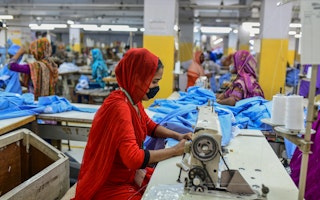Q&A: Building Labor Power and Recognition for Home-Based Workers

Home-based workers are a diverse group engaged in industries ranging from artistic endeavors like basket making and embroidery to assembling electronics and medical equipment. Recently, Open Society’s Roxanne Nazir spoke with HomeNet International’s Janhavi Dave about the best ways campaigns can advance the visibility and promote the voices of vulnerable people who work from home.
Who are “home-based workers”?
According to the United Nations’ International Labor Organization, home-based workers number somewhere around 260 million people, which is nearly eight percent of the global employed population. The majority of them are women. They are informal workers who produce goods and/or provide services from in and around their homes.
Which industries do they work in?
Home-based workers are involved in a wide range of industries. They take up intricate handwork in global garment supply chains, while also being involved in jobs like quality checking, packaging, and finishing. For example, in the textile industry, this could be trimming loose threads, adding buttons, adding drawstrings, ironing, and folding.
They also work in traditional craft industries—weaving textiles and carpets; making hand-pounded spices, traditional and local foods, and so on—and assembling parts at home for industries such as medical equipment or even automobile parts.
Why do they take up this work?
Home-based work is not always a deliberate choice, but many find that it is their only option to make a living. For women especially, home-based work often serves as an entry point into the labor force. They take it up because of the lack of other employment opportunities or because of patriarchal norms like the unfair burden of housework and childcare placed on women, which prevents them from traveling to work sites.
Do home-based workers experience an unusual degree of financial insecurity?
Yes. Home-based work is often tenuous because it is irregular and seasonal in nature. Around festival seasons, such as Eid or Diwali in South Asian countries, and when consumer demand is high, home-based workers receive work through the month, often, even working overtime to fulfill orders. But during a lean period, work may be accessible for only five or six days a month.
However, even when demand is high, home-based workers’ earnings are meager, and well below the minimum wage prescribed by their respective countries or regional governments. Since they work from home, these workers also cover many of the production costs like electricity, equipment and machines, and raw materials. This undoubtedly eats into their already limited earnings.
What kind of relationships do home-based workers have with their employers?
For home-based workers, employment relationships are hidden by design in the global supply chain. The workers rarely know their primary employers and often work for international brands through a series of suppliers, contractors, and subcontractors.
For example, Jyoti, a home-based worker affiliated with HomeNet South Asia who is in her early 20s and lives in Tirrupur, takes up job orders from clothing manufacturers. Every day, she receives bundles of clothes from a middleman who works for an export house. She receives mostly baby clothes and her job is to trim the loose threads. Generally, Jyoti doesn’t know the brand she is working for when she does this and does not receive social benefits provided to other workers in the supply chain.
How has the coronavirus pandemic affected home-based workers?
Given the nature of their industries, it is likely that home-based workers were some of the first people to realize that an economic storm was looming. We heard that work orders have been cancelled and workers have had to bear the brunt of non-payments.
For example, in early 2020, we heard from workers like Krishna Kumari Rai, a home-based worker in a remote corner of northeastern Nepal. Working with an international worker-led production company, SABAH Nepal, Rai has been exporting beautifully crafted bags, rugs, stoles, apparel, and accessories made from a natural fibre called allo, or Himalayan Nettle, to all corners of the globe. Now, all work has come to a halt and Rai is not sure when steady business will return.
Our sister organizations WIEGO and HomeNet South Asia are in the midst of researching the impact of COVID-19 on home-based workers. Some of the initial findings of these studies indicate that home-based workers received negligible amounts of work during lockdowns. And, post the lifting of lockdowns, many are still in search of any form of work. We do know there has also been an increase in domestic violence faced by home-based workers. Many home-based workers, facing violence during the pandemic, have found government programs to be inadequate and inaccessible at this time.
Most governments do not have specific policies to protect home-based workers. What would a good response from a government look like?
Despite their numbers, many governments have failed to recognize home-based workers as people in their workforce, let alone create targeted policies that help them. By recognizing their work, governments could create space for home-based worker organizations to put forth their demands and negotiate for their rights, while also creating targeted policies for home-based workers.
Although it excludes self-employed home-based workers, one way governments can show that they recognize these workers as workers is to adopt the International Labor Organization’s Home Work Convention. The convention calls for the recognition of home-based workers across sectors and nations and which obligates those who’ve signed on to adopt national policies to ensures workers are compensated fairly, able to organize themselves, enjoy maternity protection, and benefit from social programs such as retirement benefits.
As a regional and international network of home-based workers, what challenges do you face?
It is a challenge to organize home-based workers because they work in isolation and can be found across a variety of sectors. Getting these various groups to come together is a massive ask, given the differences in language, culture, politics, and in the way they organize.
We’re doing our best to fight this, though. Recently, for example, informal economy workers’ organizations came together for a global campaign called the COVID-19 and the World’s Two Billion Informal Economy Workers. Through social media, we are calling upon governments at all levels to collaborate with us to help home-based workers who are struggling because of the pandemic.
HomeNet International is a grantee of the Open Society Foundations.


